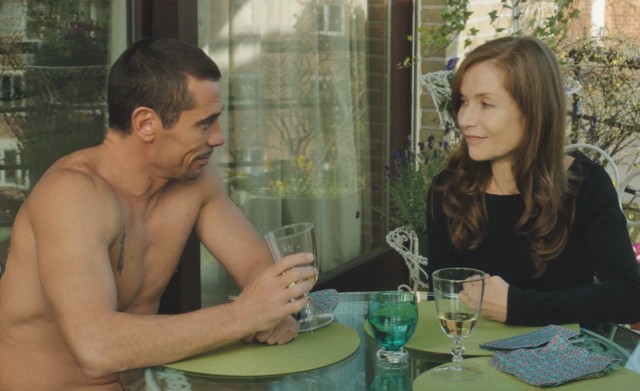Beginning in 2004, filmmaker/novelist Catherine Breillat had a series of debilitating strokes connected to a previously undiagnosed cerebrovascular disease. During her long, grueling recovery, she became fascinated by international con man Christophe Rocancourt. She decided only he could play the leading part in her next film. Their close friendship ended with a bang in 2009 — when Breillat sued Rocancourt for conning her out of nearly $1 million. No stranger to discomfiting her audience — or herself — Breillat fictionalizes that recent life chapter here, with the inimitable Isabelle Huppert as stroke-felled filmmaker/novelist “Maud Shainberg.” (Dennis Hervey)
Born in 1948 in Bressuire, France, Breillat’s bold portrayals of sexuality and gender relations attracted controversy from the outset. At 17, her first novel Easy Man was banned from readers under 18 by the French government; a decade later, her directorial feature debut A Real Young Girl (1976) stirred further outrage, going unreleased until 1999. Twelve years later, 36 Fillette, an international success, laid the path for the provocative likes of Romance (1999), Fat Girl (2001) and The Last Mistress (2008). She has also taught film studies at various European universities. (Press materials)
Please give
us your description of the film.
It is a film that is objectively more
autobiographical than others [in my oeuvre]. However, it is not more. Every
director reveals as much as they hide in their work.
Abuse of Weakness (“L’Abus de Faiblesse”) is the
legal definition in France of what I suffered. But it is also in French, a
sound, a strangeness more powerful poetically than its legal significance.
What happens to Maud is an absolute mystery. Frequently, she is much stronger than Vilco. He is “the feather,” while at the
same time he proved to [share] a sincere friendship [with Maud]. Together, they live in a place of joy and adolescent
recklessness.
The tone of the film is that of a comedy, in
particular with the bedroom scenes, where I was very inspired by the tone
of Stanley Donen’s films. It could be from Cary Grant and Stanley Donen. Only,
Vilco’s nature is to cheat and he does not allow the contrary. Maud is the
victim of [a stroke], and the beginning of the film is particularly
dramatic, the aftermath heavy. The ending is obviously dramatic. Not only
does Vilco completely rob her of all that she has, but also of all that she
is.
Some think that the ending is an absence of
response to what happens. On the contrary, when Maud repeats, “It is me, but it
is not me,” she does not say, “It is not my fault.” She denies nothing, but it is not her. She was also
dispossessed herself. She is “under the influence.” Like someone who falls into
a cult.
Isabelle Huppert only accepted the role because it was out of the question that she would be a decal of me. She is an actress who creates her roles. The ambiguity is that all of my films resemble themselves and resemble myself. She ends up being one of my characters, with a visible filiation.
What made you
write this story?
I have always had an inspiration that I call
anthropophagous.
What was the biggest challenge in making the film?
It is believed that I took a risk to exorcise what happened to me. No! That is absolutely the wrong idea. [Rather,] I kept a great distance to my own story. I would even say this with a certain
cynicism.
What advice do you have for other female directors?
This is my main advice: Be
what we make, and not who we are.
What’s the biggest misconception about you and your work?
That I want to create scandal. No, that “I am a
scandal.” I definitely understood this when my first book, A Man For the
Asking (L’homme Facile), written when I was 17, was prohibited in France for people under 18 years of age. Since then,
I have only continued to be myself.
Name your favorite women-directed film and why.
It bothers me to say Barbara Loden’s Wanda,
because I don’t want to know if it is a woman or a man who did it. I have
always considered it one of my favorite movies of all times.
What wrenches my heart, however, is the [16mm] format on
which the movie was shot. And here, it probably is because she was a woman that
she didn’t have the chance to shoot with 35mm.
It doesn’t matter. it is a movie that I wish I had made. Like Persona, like
Baby Doll, like Ivan the Terrible, like Metropolis, like In the Realm of
the Senses, like Lost Highway, but also Imamura’s Intentions of Murder.
These are movies that “we wish we had made,” that push you to do cinema. They
generated me. Wanda is a part of it.







